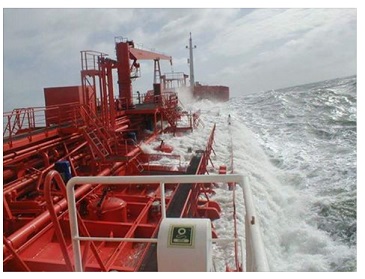
Secure all hull closures prior meeting rough seas
For Water tightness
Since requirement of closure to maintain Water tightness is concerned with both Seaworthiness and Cargo care, following attentions should be paid, especially at:
-
Watertight doors in E/R and any provided on bulkheads between cargo holds
-
Weather-tight doors (Iron doors on exposed decks)
-
Side ports for pilots boarding, if applicable
-
Access hatches or manholes leading to cargo holds or tanks
-
Hatch Covers or Tank domes, if applicable
-
Ventilators in which sea water can enter and particularly those on the forecastle
-
Fan dampers in cargo holds, except while ventilating is required
-
All sounding & ullaging pipes, and where applicable, peep holes.
a) If for any reason, any watertight or weather-tight openings are opened at sea, permission must be taken from the Master as the case may be, and same closed immediately after completion of work and reconfirmed to the Master.
b) The Chief Engineer shall ensure that the watertight doors in the machinery space, Shaft tunnel watertight door where fitted, are closed at all times, unless the space is manned.
c) The Chief Engineer shall ensure that all self-closing devices on sounding pipes and glass-gauges for oil and water tanks are functional and never tied open. (This will also prevent the oil in tank from fuelling an E/R fire)
For Fire integrity
Since Fire prevention construction may function normally, where in Fire doors are properly closed, there should be no hold-back arrangements fitted to any Fire doors and all Fire doors must be adjusted to close fully at all times.
For Shipboard Security
a) All restricted spaces, as mentioned in the Ship Security Plan, are to be always kept closed in port and in piracy-prone areas.
b) Such closures serve the dual purpose of safeguarding both the safety as well as the security of the vessel.
Related Information
Cargo ships procedures for securing for sea
Cargo ships preparation for entering in port
Cargo ships preparation for departure port
procedures for pilotage
Passage planning guideline for oceangoing ships
Ships navigation in freezing conditions and safety precautions
How to ensure safe working atmosphere onboard?
Matters that require attention after a collosion incidence
How to restore power after a collision accident with another vessel ?
Countermeasures for ships power failure
Ship in distress and protecting marine life
How to extinguish fire after a collision incidence
Stranded vessel safety check item
Requesting for salvage after own vessel involved in a collision situation
Guideline for salvage of another ship after colliding with own vessel
Missing person reported after a collision accident -how to deal?
Safety of navigation for containership
What are the steering gear check item ?
....
How to avoid navigation in heavy weather ?
....
What are the conditions that should be reported to master while navigating ship ?
....
What are the safe navigational procedure for the officer of the watch ?
....
How to deal with engine or steering gear trouble
?
....
What is gyro failure and countermeasures
?
....
How to respond with engine trouble
?
....
How to deal with ships collision accident
?
....
What is navigation in restricted visibility ?
.... Passage planning guideline for cargo ships
Guide to watch officer for ships navigation ?
Collision accident handling checklist for ships
Emergency procedure for ships main engine failure
Emergency procedure for ships power failure
How to prevent oil pollution after colliding with another vessel
Fighting fire and countermeasures after a collision incident
Stranding handling checklist after colliding with another vessel
Guideline for salvage operation after a collision accident
Guideline for salvage of another ship after collision accident
Emergency check items to find a missing crew
Salvage remunerations - benifits of L.O.F. contract or daily hire basis contract
More shipboard operation and safety matters
Safe anchoring - planning and operational guidance for cargo ships
Anchor watch check item - deck officers guideline
....
How to deal with a damaged anchor?
.... How to recover a lost anchor ?
....
What is stranding ? Investigation of possibility of self-refloating and urgency of danger
....
What are the emergency procedures for loss of anchor and chain?
....
In case of damage to anchor and chain when to claim for '' general average"?
....
Ships arrival in ports - check item prior entry
Ships navigation in restricted visibility check items
Rules of ships navigation in restricted visibility
Ships navigation in confined water - matters that require attention
Securing your vessel for sea passage - when to check and what to check
Collecting Information and Data for Passage Planning
 Other info pages !
Ships Charterparties
Other info pages !
Ships Charterparties Related terms & guideline
Stevedores injury How to prevent injury onboard
Environmental issues How to prevent marine pollution
Cargo & Ballast Handling Safety Guideline
Reefer cargo handling Troubleshoot and countermeasures
DG cargo handling Procedures & Guidelines
Safety in engine room Standard procedures
Questions from user and feedback Read our knowledgebase
Home page
 ShipsBusiness.com is merely an informational site about various aspects of ships operation,maintenance procedure,
prevention of pollution and many safety guideline. The procedures explained here are only indicative,
not exhaustive in nature and one must always be guided by practices of good seamanship.
ShipsBusiness.com is merely an informational site about various aspects of ships operation,maintenance procedure,
prevention of pollution and many safety guideline. The procedures explained here are only indicative,
not exhaustive in nature and one must always be guided by practices of good seamanship.
User feedback is
important to update our database. For any comment or suggestions please Contact us
Site Use and Privacy - Read our privacy policy and site use information.
//Home //Terms and conditions of use
Copyright © 2015 www.shipsbusiness.com All rights reserved.




